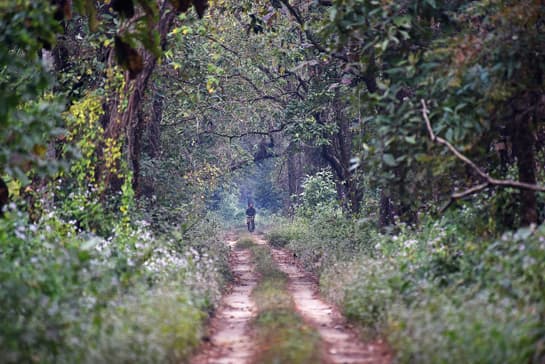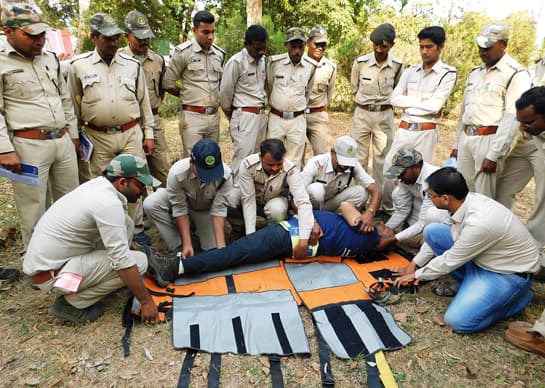Dr. Chetan (Chet) Trivedy and Rizwan Mithawala write about the Wildlife Conservation Trust’s efforts to mitigate traumatic accidents and emergencies that frontline forest staff must contend with while defending our wilds.
“Main bilkul nahi hila… Bhalu ko laga ki main mar gaya,” said M. P. Kartikey as he recounted an encounter with a sloth bear that almost killed him.
One rainy July evening in the Kanha National Park in central India, Kartikey, a forest guard then, had just finished patrolling his beat, and was making his way to the anti-poaching camp, manoeuvring through the tall, dense grass that had almost obscured the narrow trail. In the tall grass, neither man nor beast could see each other until they were uncomfortably close. To make matters worse, it was a mother bear with cubs to protect. Before Kartikey could react, the bear rose up on her hind legs. Armed with just a stick, the guard could not shield himself from the bear’s paw-swipes, and suffered severe muscle tears on his waist and chest. Knocking the guard down flat on the ground, the bear began gnawing at his skull. Luckily for the guard, the bear’s cubs called out causing the mother to retreat, only to resume her attack as he tried to escape. Muscles torn, he did something that saved his life. He played dead in a foetal position. He did live to tell the tale, but on his head is a dent-like, moon-shaped scar and in his memory is etched his near-death experience.

Photo: Anish Andheria
It took him 36 hours to reach the hospital. But despite the delay and his grievous injuries, Kartikey survived. Hundreds of others have not been so lucky. Between 2012 and 2017, India accounted for almost a third (162 of 520) of all ranger (frontline forest staff) deaths, according to the International Ranger Federation. In 2017, of the 100 rangers that died on-duty worldwide, 28 were Indians. Though animal attacks, most of which are accidental, account for the maximum number of ranger deaths in India, murders at the hands of poachers, timber and sand mafias and illegal miners come a close second. Vehicle accidents, drowning and forest fires together constitute the third major cause.
India’s frontline forest staff risk life and limb every day as they set out for their patrols. From chasing and confronting timber smugglers or illegal fishers, to being attacked or bitten by wild animals, these unsung heroes suffer injuries ranging from fractures and snake bites to bullet wounds. Senior forest officers are at risk too. In March 2018, S. Manikandan, the Director of the Nagarahole Tiger Reserve in Karnataka was charged at and trampled to death by an elephant while he was assessing damage caused by a fire allegedly set by miscreants. Tragically, all too often, timely medical help, conspicuous by its absence in remote wildernesses, could have saved the lives of these selfless heroes.

Photo: Wildlife Conservation Trust
PREVENTING AND TACKLING TRAUMA SITUATIONS
A 2014 report from the World Health Organisation (WHO) stated that 14,000 people die each day on account of injury or trauma. That totals over five million deaths every year, or nine per cent of all deaths in the world. That is 1.7 times greater than deaths from malaria, TB and HIV/AIDS combined! Trauma is in fact the greatest cause of death in the 15-19 age group and is the third most common cause of death in 30-49 year olds globally. Given the scale of this problem, trauma can certainly be considered a neglected global disease.
As might be imagined, the problem is greatly magnified in remote jungle settings. This is why many avoidable frontline-forest-staff deaths take place. If even the most basic training and equipment were on hand, lives would be saved.
This is why WCT has chosen to work towards mitigating such avoidable deaths across tiger reserves in central India. To date, 31 trauma-training camps have been held and over 1,100 frontline staff from 13 tiger reserves and one wildlife sanctuary have been trained. During these training programmes, staff are imparted practical training in skills such as cardiopulmonary resuscitation (CPR), choking first aid, management of seizures, management of snake bites, point-of-care testing for malaria, dealing with major trauma, and extrication.
Range Forest Officer Devesh Kharadi from the Kanha Tiger Reserve puts it simply, “The skills learned at WCT training camps help us buy time and prevent the patient’s condition from deteriorating till they are taken to the hospital”. As part of the training, staff members are also provided with a First Aid Field Guide for Forest Staff in regional languages. The guide informs them of health emergencies and techniques that can be used in remote locations. WCT is also developing a cost-effective and sustainable model to provide emergency trauma care and training to frontline forest staff.
Equipping forest guards in harm’s way with knowledge and skills is almost as important as ensuring that equipment and medicines are on hand during emergencies in the field. We are now focusing on ‘training the trainers’ so that Protected Areas (PAs) are able to enhance their life-saving capacity in their own landscapes. An international conference in London focused on the impact that health problems such as trauma have on conservation effectiveness is on the anvil. Christened Tulsicon2018, the initiative is being organised by the Tulsi Foundation and supported by WCT. The bottom line is that the safety of wildlife is inextricably linked to the health and well-being of wildlife protectors.
Frontline forest staff, by protecting the nation’s forests, rivers and biodiversity, ensure our access to clean air and water, and help mitigate climate change. The role of these ecosystem protectors in our national security, and the perils they face on duty, are at par with the armed forces.
Yet, inside India’s 769 PAs, there are only three effectively equipped forest dispensaries. The question must therefore be asked: Are the lives of these dharti rakshaks (earth protectors) not a priority for India?
The next article in this series will discuss in detail the problems that frontline staff face while protecting wildlife.
First published in: Sanctuary Asia, Vol. XXXVIII No. 8, August 2018.
——————————————————————————————————————————————————————
Authors: Dr. Chetan (Chet) Trivedy and Rizwan Mithawala.
——————————————————————————————————————————————————————
Disclaimer: The authors are associated with Wildlife Conservation Trust. The views and opinions expressed in the article are their own and do not necessarily reflect the views and opinions of Wildlife Conservation Trust.
Related Links
- One Health
- Reinforcing Forest Protection
- Rediscovery of Eurasian Otter
- The Guardians of our Forests
- Illegal Wildlife Trade: The Need to Look Within
